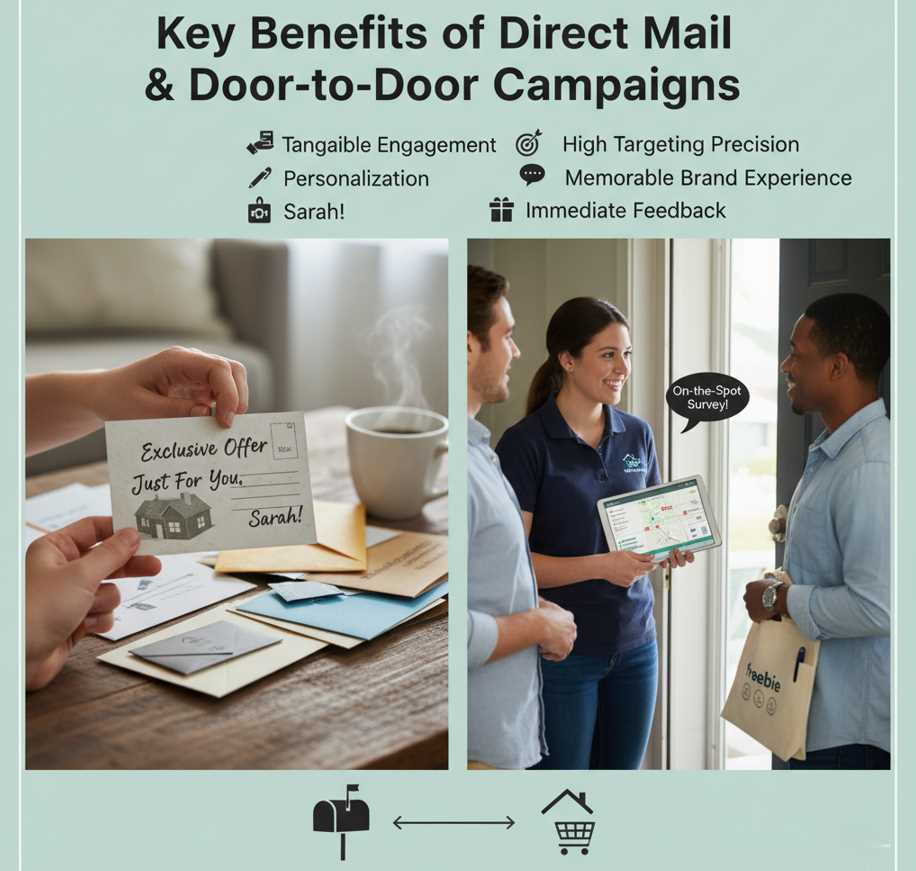In an era dominated by digital channels, traditional marketing methods such as direct mail and door-to-door outreach remain powerful tools for brands seeking deeper engagement and a tangible connection with their audience. Far from obsolete, these strategies deliver an intimate, personal touch that cuts through the screen clutter. In this comprehensive guide, we’ll explore why and how modern businesses can integrate direct mail and door-to-door marketing into their campaigns to drive measurable results.
1. Why Traditional Outreach Still Matters
Despite the rise of social media and email marketing, consumers still crave physical interactions. According to recent studies, direct mail has an average response rate of 4.9% for house lists, substantially higher than email. Door-to-door conversations build trust and allow immediate feedback. Together, these channels enable brands to stand out in a landscape where digital fatigue is on the rise.
For businesses looking to diversify their marketing mix, integrating a Traditional Advertising Strategy can provide the tangible, high-touch engagement that digital alone cannot achieve.
2. Key Benefits of Direct Mail & Door-to-Door Campaigns

- Tangible Engagement: Recipients can hold and review your materials at leisure, increasing dwell time and recall.
- High Targeting Precision: Leverage postal codes, demographic data, and purchase history to reach the right households.
- Personalization: Custom messages, handwritten notes, and localized offers foster a sense of exclusivity.
- Memorable Brand Experience: Creative formats—pop-ups, textured paper, or small freebies—leave lasting impressions.
- Immediate Feedback: Door-to-door interactions allow for on-the-spot surveys, demonstrations, and direct sales.
3. Crafting a Winning Direct Mail Strategy
To maximize ROI, follow these steps when planning a direct mail campaign:
- Define Clear Objectives: Are you promoting a new product, driving event attendance, or generating leads? Establish KPIs like response rate and conversion cost.
- Build a Quality Mailing List: Combine in-house data with reputable third-party sources. Clean your list to remove invalid addresses and duplicates.
- Design for Impact: Use eye-catching visuals, concise copy, and a strong call-to-action. Consider dimensional mailers to stand out.
- Personalize Content: Incorporate recipient names, purchase history, or local references. Segmented offers boost engagement.
- Track and Measure: Include unique promo codes, personalized URLs, or QR codes. Monitor redemptions and online traffic spikes.
To further enhance performance, consider pairing direct mail with email marketing campaigns. Sending a follow-up email after your mailer can remind recipients of your offer and reinforce your message, bridging offline and online engagement seamlessly.
4. Executing Effective Door-to-Door Outreach

Door-to-door marketing requires preparation and sensitivity to local norms. Best practices include:
- Thorough Training: Equip your team with product knowledge, objection-handling scripts, and etiquette guidelines.
- Safety & Compliance: Check local regulations, obtain permits, and ensure your staff follows neighborhood rules.
- Territory Mapping: Divide target areas into zones, balance workloads, and assign routes for maximum coverage.
- Engagement Tools: Provide branded collateral, wearable name tags, tablets for digital sign-ups, and sample products.
- Data Collection: Capture leads with mobile forms, record homeowner preferences, and update your CRM in real time.
5. Measuring Success: Metrics That Matter
Pair qualitative feedback with quantitative metrics to evaluate performance:
- Response Rate: Percentage of recipients who take the desired action (e.g., redemption, sign-up).
- Conversion Rate: Number of sales or leads divided by total mailers distributed or doors knocked.
- Cost per Acquisition (CPA): Total campaign spend divided by the number of new customers or leads.
- Return on Marketing Investment (ROMI): (Revenue attributed to campaign – cost) ÷ cost.
- Qualitative Feedback: Insights gathered from face-to-face conversations and survey questions.
6. Integrating Offline & Online Channels
To amplify impact, synchronize your traditional tactics with digital efforts:
- QR Codes & PURLs: Bridge print to online by offering exclusive content or discounts via quick scans or personalized URLs.
- Retargeting Campaigns: Use mailing lists to create custom audiences for social media and display ads.
- Cross-Channel Promotions: Promote offline events through email blasts and social posts, and vice versa.
- Unified Analytics: Consolidate offline response data with digital analytics for a holistic performance view.
7. Case Study Highlights
Consider a regional home services brand that combined a bespoke direct mail piece with door-to-door demos. By using variable data printing, they personalized offers based on neighborhood demographics. Their sales reps captured leads on tablets, enabling real-time follow-up emails. The campaign generated a 12% response rate, a 3.5X ROMI, and a significant uplift in brand awareness within just four weeks.
8. Budgeting & Resource Allocation
Allocate your marketing budget by weighing production costs (printing, materials), distribution fees (postal rates, canvassing labor), and tracking tools (software, promo codes). A balanced split might reserve 60% for direct mail, 30% for door-to-door execution, and 10% for integrated digital amplification and analytics solutions.
9. Implementation Roadmap
Follow this step-by-step process to launch your campaign seamlessly:
- Research & Segmentation
- Creative Development
- List Procurement & Cleansing
- Print & Collateral Production
- Pre-Launch Testing
- Distribution & Canvassing
- Data Collection & Follow-Up
- Performance Analysis & Optimization
10. Conclusion & Next Steps
Direct mail and door-to-door marketing offer time-tested pathways to meaningful customer connections. When executed with precision—backed by personalization, integrated analytics, and digital reinforcement—these traditional tactics can yield exceptional ROI. Begin by defining your objectives, assembling the right resources, and embedding measurement at every stage. Embrace the tangible power of offline engagement to complement your digital efforts and watch your brand loyalty and conversions soar.
Ready to launch your next direct mail or door-to-door campaign? Get in touch with our experts to craft a bespoke strategy tailored to your audience and business goals.
Learn more about: How Is Digital Marketing Different From Traditional Marketing?









